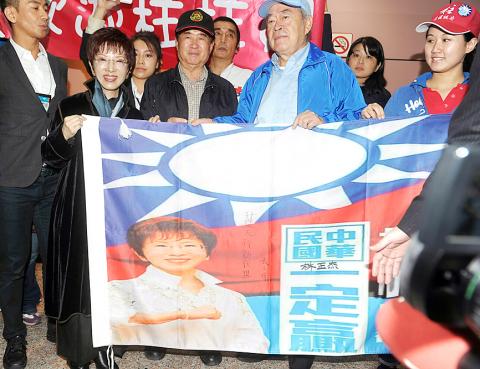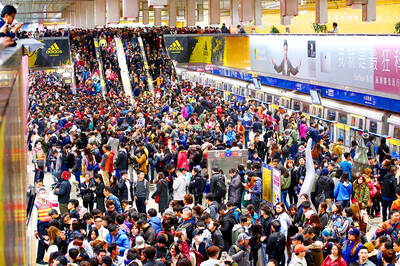The Chinese Nationalist Party (KMT) will continue to hold an annual cross-strait forum with the Chinese Communist Party (CCP) to maintain cross-strait peace and interactions, KMT Chairwoman Hung Hsiu-chu (洪秀柱) said yesterday after arriving in Taoyuan from a trip to China.
Hung landed at Taiwan Taoyuan International Airport at about 5pm, where supporters greeted her chanting “Sister Chu Chu [Hung’s nickname], I love you!”
“During my five-day visit, we were welcomed enthusiastically. Sincerity and goodwill were demonstrated by both sides at my meeting with the leader on the other side of the Taiwan Strait [Chinese President and CCP General Secretary Xi Jinping (習近平)]. The Taiwanese businesspeople and students I met also recognized our efforts and expressed hope that cross-strait exchanges be continued,” she said.

Photo: CNA
Eight cities and counties governed by the pan-blue camp or independents are to sponsor a tourism and cultural exhibition in China at the end of this year as a result of this week’s KMT-CCP forum in Beijing, Hung said.
The KMT would continue to push for things that are conducive to the welfare of Taiwanese, she added.
A delegation of six KMT and two independent local government leaders visited Beijing in September, where they offered their acceptance of the so-called “1992 consensus” in exchange for preferential tourism treatment by China.
Before leaving Beijing yesterday, Hung visited the Taiwan Hall in the Great Hall of the People, where she said that the current atmosphere across the Taiwan Strait prompted the KMT to attempt new breakthroughs.
“It is an unshakable responsibility that we will not pass on to others… However, the mountain top cannot be reached in a single leap,” Hung said, adding that moving cross-strait relations forward required step-by-step effort, continuous communication, exchanges and mutual empathy.
Hung said that she has gained a lot from her exchanges with Chinese officials during her trip, expressing confidence that these gains would be helpful to future interactions and peaceful and stable development across the Strait.
Hung and her delegation first visited Nanjing to pay tribute to Republic of China founder Sun Yat-sen (孫中山) at his mausoleum, before heading to Beijing.
She met with Xi on Tuesday and then attended the two-day Cross-Strait Peaceful Development Forum.
The KMT and CCP annual forums began in 2006, after former vice president and then-KMT chairman Lien Chan (連戰) visited China in April 2005.
The so-called “1992 consensus,” a term former Mainland Affairs Council chairman Su Chi (蘇起) admitted to making up in 2000, refers to a tacit understanding between the KMT and Beijing that both sides of the Strait acknowledge there is “one China,” with each side having its own interpretation of what “China” means.

People can take the Taipei MRT free of charge if they access it at Nanjing Sanmin Station or Taipei Arena Station on the Green Line between 12am and 6am on Jan. 1, the Taipei Department of Transportation said on Friday, outlining its plans to ease crowding during New Year’s events in the capital. More than 200,000 people are expected to attend New Year’s Eve events in Taipei, with singer A-mei (張惠妹) performing at the Taipei Dome and the city government’s New Year’s Eve party at Taipei City Hall Plaza, the department said. As people have tended to use the MRT’s Blue or

Civil society groups yesterday protested outside the Legislative Yuan, decrying Chinese Nationalist Party (KMT) efforts to pass three major bills that they said would seriously harm Taiwan’s democracy, and called to oust KMT caucus whip Fu Kun-chi (傅?萁). It was the second night of the three-day “Bluebird wintertime action” protests in Taipei, with organizers announcing that 8,000 people attended. Organized by Taiwan Citizen Front, the Economic Democracy Union (EDU) and a coalition of civil groups, about 6,000 people began a demonstration in front of KMT party headquarters in Taipei on Wednesday, organizers said. For the third day, the organizers asked people to assemble

Taipei is participating in Osaka’s Festival of Lights this year, with a 3m-tall bubble tea light installation symbolizing Taiwan’s bubble tea culture. The installation is designed as a bubble tea cup and features illustrations of Taipei’s iconic landmarks, such as Taipei 101, the Red House and North Gate, as well as soup dumplings and the matchmaking deity the Old Man Under the Moon (月下老人), affectionately known as Yue Lao (月老). Taipei and Osaka have collaborated closely on tourism and culture since Taipei first participated in the festival in 2018, the Taipei City Department of Information and Tourism said. In February, Osaka represented

Taiwanese professional baseball should update sports stadiums and boost engagement to enhance fans’ experience, Chinese Professional Baseball League (CPBL) commissioner Tsai Chi-chang (蔡其昌) told the Liberty Times (sister paper of the Taipei Times) in an interview on Friday. The league has urged Farglory Group and the Taipei City Government to improve the Taipei Dome’s outdated equipment, including relatively rudimentary television and sound systems, and poor technology, he said. The Tokyo Dome has markedly better television and sound systems, despite being 30 years old, because its managers continually upgraded its equipment, Tsai said. In contrast, the Taipei Dome lacked even a room for referees